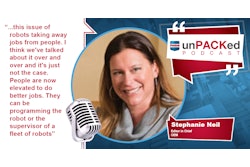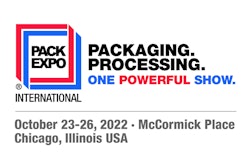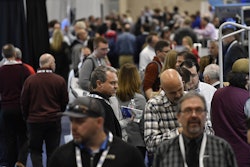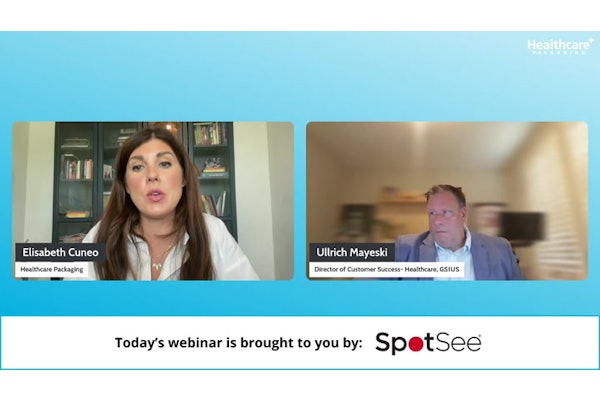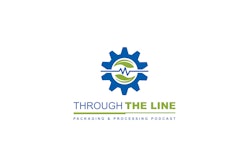UnPACKed with PMMI continues its look back at PACK EXPO East with PMMI Media Group’s Automation Guru Dave Greenfield from Automation World and Packaging World’s Natalie Craig. The pair highlight exciting machinery finds from the show floor, ideal for emerging brands looking to make their first inroads into packaging via form/fill/seal. Greenfield also breaks down the emergence of automation software as a tool for everything from determining OEE to helping operations lay out a clear case to the executive suite on why automation spending almost always reveals immediate ROI.
Missed part one of our unPACKed with PACK EXPO East series? Listen here.
To subscribe, rate, review and find more unPACKED podcast episodes, visit pmmi.org/podcast or find us on Apple podcasts, Spotify or iHeart Radio.
 | Read the full transcript below. |
Sean Riley:
Day two is usually when a show really starts to hit its stride, so I'm sure that Natalie and Dave have some great things to bring to the table. So with that, Natalie, what have you seen out there so far?
Natalie Craig:
I made a couple of circles around Unified Flex. They had quite a big crowd over their vertical form fill seal, which is an entry level piece of equipment.
Natalie Craig:
It does a couple of different pack styles, it does a pouch, a three seal, a four seal, and a stick pack, which is really appealing to people who have to run different packaging sizes, but also companies who are just making their way into automation and putting packaging equipment on their floor. So that was really interesting. It had a big crowd. I had to make a couple of circles back to them.
Sean Riley:
I don't want to interrupt, but that's interesting. We get a lot of smaller companies that are coming to a packaging show for the first time, and might not understand how complex or what is available to them.
They hear automation, they think huge lines that they don't have the space for. So that sounds like something, "I have a startup, mom and pop, that this is how I get into a packaging instead of doing it myself."
Natalie Craig:
And I think that's why there was such a big crowd. Because you see a lot of people who are just barely getting their brand off the ground, but they need a way to package something efficiently and package a lot of things too.
And so, their machine was compact. It had quite the crowd. I've seen a lot of equipment like that, that's compact entry level, semi-automated, or fully automated. All of those capabilities and that flexibility is really important.
Sean Riley:
You've decided to bring your mom and pop operation out of the garage. You've been putting it in bags yourself. Now I'm going to ramp it up a little bit. I love it.
Natalie Craig:
Yeah.
Sean Riley:
What else?
Natalie Craig:
I saw an automated cartoner, it's compact at around 20 feet long. It's also really great for entry level companies, or even contract packages who don't have a lot of facility space.
Natalie Craig:
The really cool thing about this cartoner, is that it's also very flexible. So you could do a hand load operation, or you could fully automate it and connect it to other pieces of equipment. And so, that was also really popular. It's brand new at PMI KYOTO.
Sean Riley:
If your business continues to expand, that's going to give you different options down the line versus just being locked in with one thing. So I like that flexibility. That's something that everybody is, obviously, always looking for here.
Natalie Craig:
For sure.
Sean Riley:
So, Dave, what have you seen out there? You're our automation guru. What fancy things do we have out there on the floor?
Dave Greenfield:
Obviously, attending any PACK EXPO show, you see all of the equipment, all these systems. And from an automation standpoint, I'm looking, typically, at the controllers, the linear actuators, obviously the robots and the cobots that everybody sees.
But a couple of things that stood out to me at this event and that I'm seeing coming more to the fore across the industry, is a focus on software.
And not just the software that you use to interact with on the machine, through the HMI to operate it, but also as a strategic tool as well.
Two software companies that I've met with here, specifically, focus their systems around OEE. Which is a really well known industry metric that's been around forever.
PMMI's OpX Leadership Network addresses it with their guidelines and tools. But in these different software packages, they're being used as part of one system.
It's a component part that addresses everything from labor issues to regulatory compliance. And then in another one, it's being used as a top business metric to not only handle the maintenance issues on the equipment, which is typical for OEE, but also to help justify automation investments for CapEx expenditures across the plant floor with that.
Speaking of that one, that was OEE systems International. And when I was speaking with Andrew Rice there, he was talking about how the digital transformation initiative across industry is really driving a focus on continuous improvement at companies of all types.
And that's where he sees OEE as a business metric to be used to link it to financial systems for the CapEx investments.
And so that, at the executive suite level, they can understand what even a 1% gain in OEE efficiency means to the business as a whole. So that was the key thing with that.
This software can run on a server on equipment, or in the cloud, which is a interesting connection to the other piece of software that I saw from SafetyChain.
That is a total software as a service application that you subscribe to it. It's delivered from the cloud. That's the one that I was referring to earlier, that addresses everything from labor issues on through to compliance.
It's actually used to track worker steps and worker input from everything, from receiving to processing. It also has OEE and statistical process control, and on through to regulatory compliance.
And a big issue with this software, as Kevin Lee, who I met with there was telling me, is you can personalize it. And easily personalize without having to program the software that you can create forms in it.
And an example he gave was recently during COVID, one of the government agencies had added a new requirement, that they had to tell how many fans they had in the facility for ventilation reasons.
That was something they didn't normally track for regulatory compliance in a food processing plant, for this agency, anyways. And they were able.
And this was something that the company initially looked at and thought was going to be a huge undertaking to add this to their form.
But with this software, they were able to create a form in one instance, send it out to all the plants. Which was very easy for each of the plants to input that information in.
Because the guys in the plant know how many fans are in there. And they had all that information within 24 hours. And that software links to the regular compliance agencies so that they can see the data externally. So you don't have to prepare for an audit. The agencies can see that data in their system via a web browser.
Sean Riley:
You said so many things that-
Dave Greenfield:
I know
Sean Riley:
No, no. ... that triggered thoughts in my head that I have to now sort them out. And in my age, that's not easy.
Sean Riley:
The first thing I was thinking, and you touched on that, was, every study that we see, every business intelligent PMMI puts out, every story that you seem to cover on automation, the hardest thing is getting the people on the floor; the operations people, the engineers that are putting it together, need this automation.
They need this or robotics to make it work. But getting that all the way up the chain to the executive level and getting them to sign off on that, seems probably their most difficult challenge, often.
And what you are saying with this simple OEE... Not that OEE is simple. I'm not going to try to explain it. But it is relatively simple in this case, it's something that they can use this to technology for as well.
Dave Greenfield:
Yap. Beyond showing the plant floor workers what to focus on and where they should be focusing their maintenance efforts, it then shows the executive level what things are costing them.
And then, like I said, how to justify investments on, "Do we add a new line? Do we add a new machine? And what can we expect is an ROI from that based on what we're seeing currently, does this machine run faster? Does it have a higher throughput?" Whatever the case might be, it helps and then justify that calculation.
Sean Riley:
And then, with software as a service, it immediately makes me think that this is something that is allowing the people on the floor to be more invested in their job.
They are solving a problem with this government came in and government regulation that they needed to have, how many fans, we need to be able to report on this.
And it's something simple that, they're on the floor and they're figuring out on the fly, how many that is. It keeps them more invested in their job versus, again, the manufacturing, as this dirty facility where you're just putting stuff in a box over and over.
This is something where they're literally solving a problem that goes all the way up the chain. And I have to think that's something that's going to empower them as workers, which we know is a difficult thing in our workforce for manufacturer.
Dave Greenfield:
And it gives them direct feedback. As well as they enter information into the system, it gives them feedback. If a weight of a package is over or under, it gives them immediate feedback on the task list. If that's over the set parameters in the system, so they can make adjustments right then and there on the spot.
Sean Riley:
I really love that. It gives you that sense of empowerment. So those are four great things that attendees should take a look at. If you aren't at the show, please visit our virtual exhibits online.



